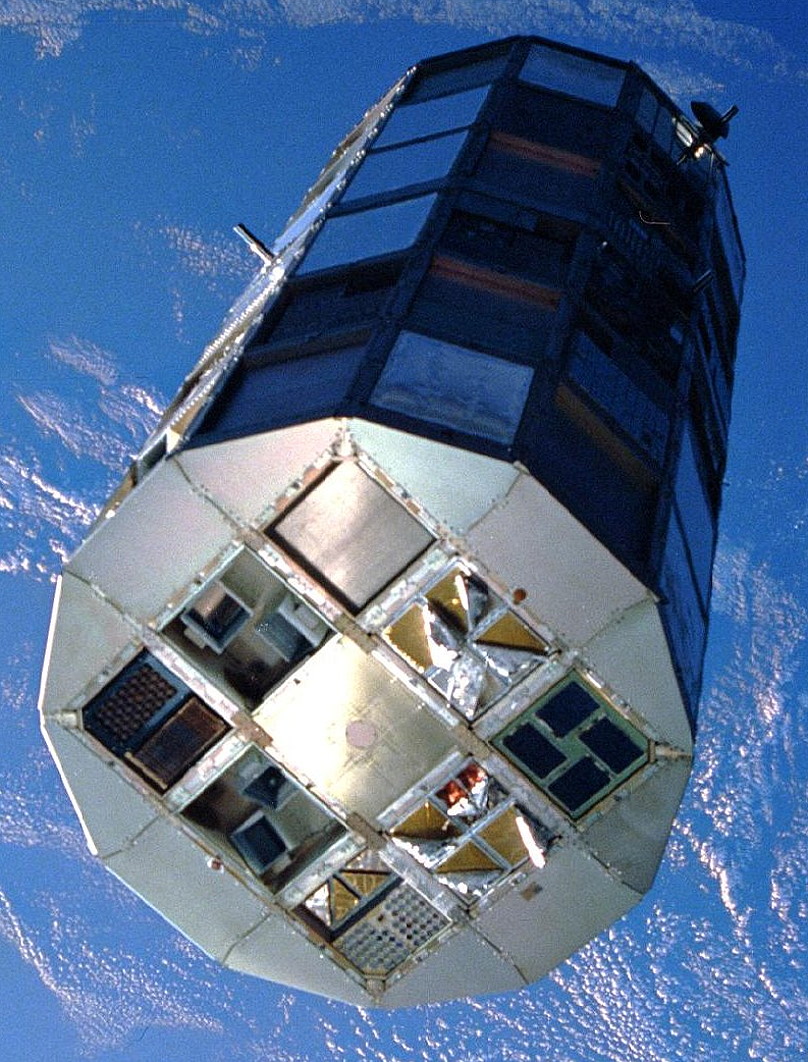
A quarter-century ago, next week, the crew of Columbia embarked on the longest shuttle mission in history at the time, deploying one satellite, retrieving another, and setting the sights of NASA on the Space Station Era. As described in yesterday’s AmericaSpace history article, STS-32 astronauts Dan Brandenstein, Jim Wetherbee, Bonnie Dunbar, Marsha Ivins, and David Low were tasked with placing the U.S. Navy’s fifth and final Syncom 4 military communications satellite in orbit and capturing NASA’s Long Duration Exposure Facility (LDEF), whose retrieval had been repeatedly delayed in the aftermath of the Challenger tragedy. By the time Brandenstein and his crew reached LDEF on the morning of 12 January 1990, three days into their mission, the satellite was thought to be only a matter of weeks away from an uncontrolled and destructive re-entry.
With the successful deployment of Syncom 4-5 behind them, the astronauts turned their attention to LDEF. At the time of their launch, they trailed the giant satellite by about 1,700 miles (2,730 km) and were closing on their quarry by about 37 miles (60 km) with each orbit of Earth. Three flawless maneuvers were performed by Brandenstein and Wetherbee on 9 and 10 January to reduce this distance, and Flight Director Bill Reeves exulted to journalists that everything was proceeding smoothly toward the rendezvous. On the morning of the 12th, the astronauts were awakened to music from Mission Control: Bring it Home, set to the melody of Let it Snow. Due to the extreme sensitivity of LDEF’s 57 materials science experiments, the final approach was as unobtrusive as possible to minimize the risk of contamination. From a distance of 25 miles (40 km) down to just one mile (1.6 km), Columbia’s radar and star tracker locked onto their target and permitted Brandenstein to move closer. He then took manual control of his ship, passing “below” and “ahead” of the satellite, then pitching the shuttle’s nose “upwards” to achieve a position directly “above” LDEF. Jim Wetherbee, positioned in the commander’s seat on the flight deck, related that this was essential to keep the closure rates slow and smooth when approaching such a massive object.
Wetherbee was astonished as the gigantic LDEF “hung” above Columbia’s cavernous payload bay. By this point, the astronauts—who had watched computer-generated views in simulators for more than a year, since their assignment to STS-32 in November 1988—saw the real thing, waiting to be captured. It had traveled almost 800 million miles (1.3 billion km), or roughly the distance between Earth and Saturn, and had completed 32,000 orbits of the Home Planet. As they looked at it, the crew noticed that LDEF had suffered some damage during its six years aloft: A small solar cell had apparently dislodged itself and was flying in formation with the satellite, whilst a number of holes, apparently from micrometeoroid impacts, were evident. After the retrieval, the Interim Operational Contamination Monitor (IOCM) in the shuttle’s payload bay revealed that it had also sustained a fair amount of particulate debris.
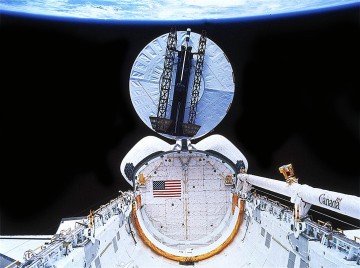
From her perch on the aft flight deck, Bonnie Dunbar focused the wrist camera of the Canadian-built Remote Manipulator System (RMS) mechanical arm onto LDEF’s starboard side and prepared to grapple it. Brandenstein then performed a yaw maneuver to align the wrist camera with the grapple fixture. By this point, the satellite was directly above the cabin, as the pilots maintained formation in an inverted orientation. When she saw the grapple fixture in the wrist camera monitor, Dunbar went in for the kill. She rotated the camera by 180 degrees to the correct retrieval position, and at 10:16:05 a.m. EST on 12 January 1990, whilst over the Atlantic Ocean, near Brazil, she grasped it.
Brandenstein called Mission Control. “Houston, Columbia,” he said, “we have LDEF!”
“You’ve made many scientists very happy that their LDEF experiments are finally coming home,” replied Capcom Tammy Jernigan. In the background, the crew could hear the sound of applause. In fact, it was the first of many accolades for the astronauts that day. Lead Flight Director Al Pennington called it “the culmination of a lot of work by a lot of people,” and NASA Administrator Dick Truly expressed his admiration as he “watched America’s space program at its best.” According to LDEF Chief Scientist William Kinard, the excitement of investigators from around the world, from the United States to Europe and even as far afield as Australia, was audible. Immediately after the retrieval, Columbia’s General Purpose Computers (GPCs) commanded the RMS to align LDEF with the payload bay’s berthing guides and Dunbar lowered the satellite into position at 3:49 p.m. EST. “It looks like LDEF is going to join us for the ride home,” Bill Reeves remarked.
Marsha Ivins, meanwhile, had spent the past 4.5 hours painstakingly photographing each and every surface of the satellite for the benefit of engineers. To assist, Dunbar rotated LDEF slowly on the end of the mechanical arm. Due to the sheer size of the satellite, there was a real risk that the crew might not be able to latch it properly into the payload bay and, in a worst-case scenario, might have to leave it behind it orbit. “So we wanted to at least get the pictorial data,” Dunbar recalled. “We also put video down to the ground. That took several hours, but we were able to do that and then got it latched and brought it back.” By the time that Ivins’ 4.5-hour period of focused photography was done and the RMS stowed, the crew had been awake for almost 17 hours, but, according to Brandenstein, “all the faces up her are smiling and happy.” Clearly, the triumph had raised their spirits—to such an extent, in fact, that they transmitted cartoon picture to Mission Control the following morning, showing LDEF literally imprisoned within a web of overgrown tomato seeds. “We saw something … strange,” Brandenstein grinned, “so we got it on the video recorder and thought we would show it to you.” The tongue-in-cheek cartoon was a quip at the 12 million tomato seeds flown by students aboard LDEF, which had seemingly overgrown after their long stay in orbit!
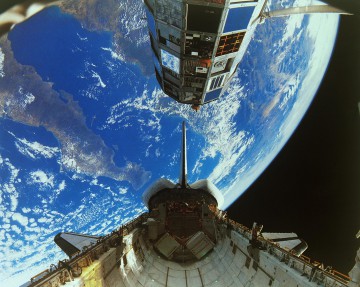
With both primary objectives of their mission—the deployment of the Syncom 4-5 and the successful recovery of LDEF—now behind them, the crew settled down to a week of scientific and medical experiments. Planned for nine days and 21 hours, STS-32 was expected to come within ten hours of the duration of the longest shuttle mission to date, STS-9. “This is the second longest shuttle mission we’ve had so far,” said David Low on 13 January, “so we can do some good science experiments up here and get some very good medical data.” His words would prove ironic, if not a little prophetic, for Columbia would break her own endurance record, set during STS-9, and fly for almost 11 days.
One avenue of study for the astronauts was materials processing in microgravity, and Dunbar spent a great deal of her time tending the Fluids Experiment Apparatus (FEA) in the middeck. This device was capable of heating, cooling, mixing, stirring, or imposing centrifugal force on gases, liquids, or solids and had been carefully designed to meet industrial requirements. Dunbar supervised the processing of seven samples of indium—a well-characterized material with a low melting point—to assess the effect of disturbances induced by the shuttle’s thruster firings or the movements of crew members. It was anticipated that results could lead to more advanced versions for Space Station Freedom. The FEA was activated a few hours after STS-32 reached orbit and ran successfully for almost a full week, until a sensor indication showed that it had exceeded its touch-temperature limit. The unit shut itself down, as programmed, but the astronauts reported that it did not seem to be hot. Nevertheless, after a week of operations, it had achieved more than three-quarters of its objectives.
Meanwhile, Ivins and Low tended to a series of protein crystal growth investigations. Ivins was also responsible for the American Flight Echocardiograph (AFE), an off-the-shelf ultrasound device, specially modified for carriage aboard the shuttle. It had the potential to non-invasively generate three-dimensional, cross-sectional imagery of the heart or soft tissues and display it on a monitor. During the mission, the echocardiograph was used in conjunction with a Lower Body Negative Pressure (LBNP) instrument, which resembled a collapsible set of “trousers,” which drew fluids into the legs as a countermeasure for the punishing effects of a return to terrestrial gravity.
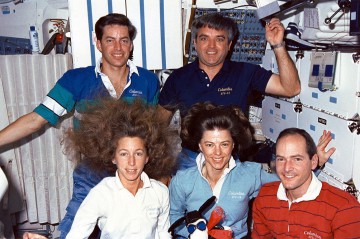
Several commanders had objected to the medical experiments, but since becoming chief of the astronaut office, Brandenstein had seen them as part of the job. “I was very demanding on the experiments that they do have real merit,” he told the NASA oral historian, “and be well-organized and have a test plan, not a willy-nilly type experiment.” During his tenure as chief astronaut, Brandenstein had convinced the rest of the office that science was part of their job when in orbit. “You lead by example,” he said, but his enthusiasm was perhaps pushed a little far by physician-astronaut Manley “Sonny” Carter, who talked the crew into “the granddaddy of all experiments”—an incredibly painful muscle biopsy. Surprisingly, Brandenstein’s crew were game and volunteered to have hunks of muscle pulled out of their legs both before and after the mission.
Despite its impressive success, the flight was not entirely smooth sailing. On 11 January, several liters of water oozed from a leaking dehumidifier onto the middeck. After switching it off and activating a backup, Brandenstein joked that his crew had won the Plumber of the Year award … but not Housekeeper of the Year. A more serious problem arose on the 14th, when he was awakened by Mission Control, following an indication of trouble with one of Columbia’s Inertial Measurement Units (IMUs), a critical part of the navigation hardware. Although he reset the unit and returned to sleep, Flight Director Al Pennington worried that any other problems could result in an early end to the mission. Another key issue factoring into the chance of an early landing was the weather outlook at Edwards Air Force Base, Calif., where skies were forecast to be overcast, with a chance of snow flurries, on 17 and 18 January. Thankfully, a shortened mission was unnecessary and revised weather estimates predicted dry conditions, scattered clouds, and light winds—coupled with frigid temperatures—for the 19th.
With LDEF in her payload bay, Columbia would tip the scales at a mammoth 227,960 pounds (103,400 kg), which meant that the dry lakebed Runway 17 would be too soft and perhaps cause controllability problems. NASA therefore decided to land on the concrete Runway 22, but even that posed its own challenges. The presence of LDEF shifted the orbiter’s center of gravity “forward,” meaning that without deft handling of the vehicle, the nose gear might “slap” down too hard onto the runway. In a press conference, fielded whilst in orbit, Brandenstein told journalists that he needed to maintain sufficient speed after main gear touchdown in order to gently rotate the nose down.
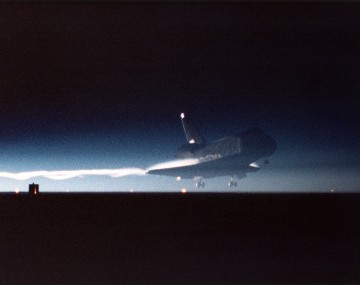
Despite hopes that the weather would co-operate for a landing at 1:59 a.m. PST (4:59 a.m. EST) on 19 January, a wave-off seemed likely because a dusting of snow at Edwards the previous day had left water on the runways, and there was a chance of fog. According to spokesman Kyle Herring on the evening of the 18th, the weather remained marginal. Notwithstanding this potential obstacle, the crew marched through their pre-landing checks of Columbia’s flight surfaces and controls … but to no avail. As feared, the fog prompted a 24-hour delay. “We’re looking and watching the weather,” said Bill Reeves on the evening of the 19th. “Edwards is improving for tomorrow.”
In fact, no fewer than four landing opportunities existed on 20 January, followed by three more on the 21st and the shuttle could conceivably remain aloft until the 22nd if needed, possibly producing a record-setting 13-day flight. The mission could have landed in Florida or at White Sands, N.M., but NASA elected to hold out for Edwards, aware that its wide runway provided a more forgiving environment for Columbia with the heavy LDEF payload aboard. As they waited for the weather to improve, the STS-32 crew enjoyed a light day on the 19th, quietly surpassing the STS-9 record in the mid-afternoon. Brandenstein also became the most experienced shuttle astronaut, having notched up more than 570 hours on three missions. In doing so, he surpassed Bob Crippen, but admitted that each and every hour was enjoyable. On the 17th, he had celebrated his 47th birthday in orbit and an inflatable plastic cake had been smuggled aboard by his crewmates. He also received a chorus of pre-recorded greetings from the rest of the astronaut office and a message from basketball star Larry Bird, who congratulated him on the “slam dunk with LDEF.” When questioned by Mission Control about his age, Brandenstein, alluding to Einstein’s theory of relativity, replied that he had hoped that flying at Mach 25 would have slowed down the aging process. …
The return to Earth on 20 January was successful, although a switch failure in one of the computers during de-orbit preparations led Mission Control to wave off the first landing opportunity of the day. Ironically, the particular computer which failed carried the backup flight software to be used if the four primaries failed. To play things safe, the backup software was loaded into one of the primaries and the failed unit was shut down for the rest of the flight. It was a nail-biting time. Brandenstein and Wetherbee were minutes away from firing the Orbital Maneuvering System (OMS) engines to begin the irreversible de-orbit burn, with touchdown scheduled for midnight PST (3:00 a.m. EST), when the computer glitch arose. The engines were finally fired for five minutes at 12:30 a.m. PST (3:30 a.m. EST), slowing Columbia and dropping her into the upper reaches of the atmosphere. No radio “blackout” was experienced, because constant communications were possible through the Tracking and Data Relay Satellite System (TDRSS).
Soaring through the darkness, Columbia touched down on concrete Runway 22 at 1:35:35 a.m. PST (4:35:35 a.m. EST). “Welcome home. Outstanding job,” radioed Capcom Mike Baker from Mission Control, as Brandenstein brought the vehicle smoothly along the centreline. “You showed the shuttle at its best, deploying and retrieving satellites.” All six wheels stopped a minute later, setting a new shuttle program duration record of 10 days, 21 hours, one minute, and 39 seconds … a record which would endure for another two and a half years. “Records are there to be broken,” admitted Bonnie Dunbar, “but we were just glad to get another day in space.” For Dunbar, the breaking of records would characterize the rest of her career. On her next mission, also aboard Columbia, in June 1992, she would exceed her own record from STS-32, by spending 14 days aloft. That would be the first in a series of long-haul flights, featuring a new system known as the Extended Duration Orbiter (EDO).
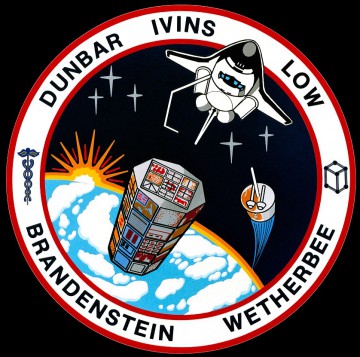
Columbia herself returned to Florida on 26 January and LDEF was removed from her payload bay. Excited scientists had been permitted to photograph their precious payload from the aft flight deck windows at Edwards, but it was not until the orbiter was back on the East Coast that they could get their hands on the satellite properly. For the next two months, radiation levels were monitored, infrared video surveys were made, contamination was recorded, and thousands of photographs were taken. LDEF was intact, but certainly weathered after six years in space. Clear evidence existed of “pitting” as a result of micrometeoroids punching into her outer surfaces, and some erosion to a Kevlar thermal cover on her space-facing end. “I think the conclusion that we all came away with,” said William Kinard, “is that you have to be cautious in designing a spacecraft.”
Organic materials exhibited severe erosion from atomic oxygen, whilst “coated” composites generally survived and maintained their mechanical properties, but due to the extended nature of the mission a few of the thin polymeric films and blankets had been completely destroyed; they had deposited their debris on adjacent areas of the spacecraft. A low-density particulate “cloud” was also spotted in LDEF’s wake and many of the satellite’s surfaces showed brownish discoloration. Yet the six years endured by LDEF in the harshest environment known to mankind had actually provided a tremendous service to the engineers and technicians, who were at that time working on the kinds of materials best suited for Space Station Freedom. In many ways, the achievements of STS-32—from its long duration to putting the shuttle through its pace in dramatic and spectacular fashion—had laid many of the foundations for what NASA would need in order to build the station.
This is part of a series of history articles, which will appear each weekend, barring any major news stories. Next week’s article will focus on STS-72, a multi-faceted shuttle mission from January 1996, which involved satellite deployment and retrieval, rendezvous, and spacewalking, and set the stage for the work required to build the International Space Station (ISS).
Want to keep up-to-date with all things space? Be sure to “Like” AmericaSpace on Facebook and follow us on Twitter: @AmericaSpace




Very nice overview. I was lead ‘Rendezvous Officer’ in the MCC for this mission, my second front room assignment, and it was dramatic. Here’s a pix of our console, note my cardboard model of the LDEF we used for orientation visualization during final approach.
http://www.jamesoberg.com/image/mcc.jpg
Not to nitpick, but the third picture in the article is actually from STS-41-C when LDEF was released (note the service structure for the SolarMax satellite in the payload bay), not from STS-32.
is LDEF on display in a museum these days or what happened to it?